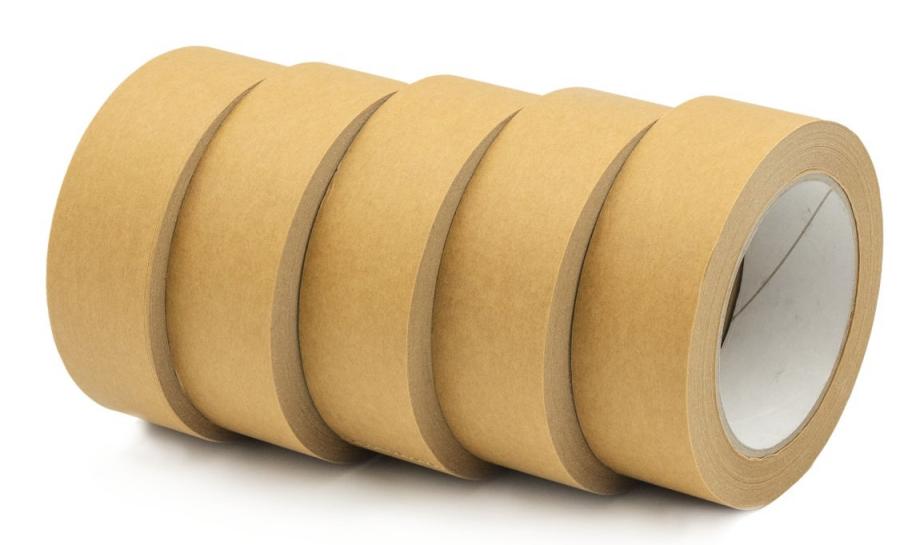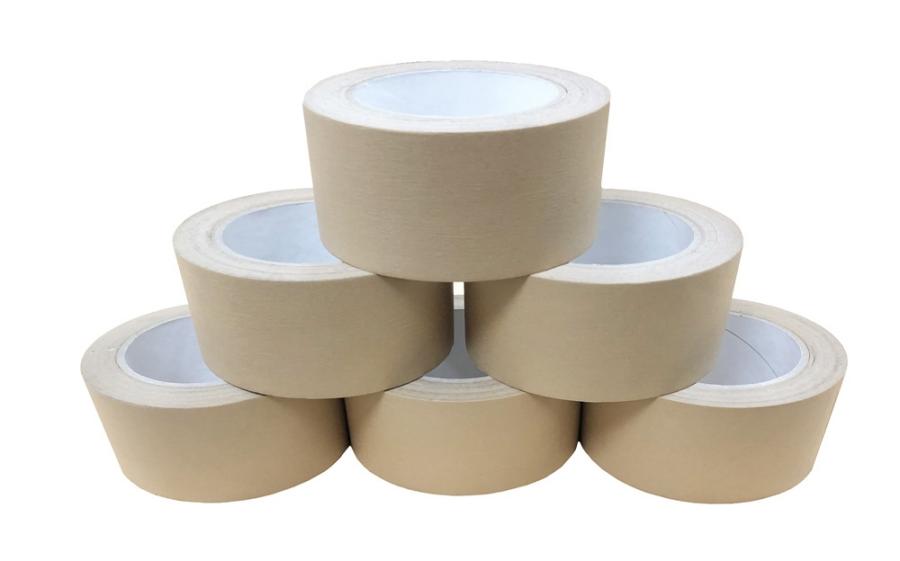Environmental Friendly Kraft Tape: A Sustainable Choice
The 21st century has witnessed a profound shift in global consciousness, where environmental concerns have transitioned from the periphery of public discourse to its very center. As the tangible impacts of climate change, deforestation, and pollution become more evident, there’s a burgeoning recognition of the urgency to adopt sustainable practices. This heightened awareness isn’t just evident among environmentalists or policymakers but has permeated households, schools, and businesses, creating a collective effort towards preserving our planet.
In this atmosphere of proactive environmentalism, every product, process, and policy is being re-evaluated for its ecological footprint. Among the myriad of innovations sprouting from this green revolution is the environmental-friendly Kraft tape. At first glance, it might seem like a simple adhesive solution, but its significance runs deep. As a sustainable alternative to conventional plastic tapes, Kraft tape symbolizes our evolving commitment to the environment. It demonstrates how even seemingly small changes in our daily choices can cumulatively lead to a significant positive impact on our planet.

What is Kraft Tape?
Definition and Basic Properties
Kraft tape, often recognized by its signature brown hue, is a pressure-sensitive tape made primarily from Kraft paper. Kraft paper derives its name from the Kraft process, a method used in converting wood into wood pulp, which is then utilized to produce paper. This process gives Kraft paper its distinct strength and durability.
Unlike traditional plastic tapes, which have a shiny surface and can be slippery, Kraft tape possesses a matte finish and is often more textured. One of its salient features is its strong adhesive property; when moistened, it can adhere securely to packages, making it a favorite for various sealing requirements. Additionally, because it’s paper-based, Kraft tape is easily tearable by hand, offering convenience in application.
Materials Used in Environmental-Friendly Kraft Tape
The primary material in Kraft tape is, as mentioned, Kraft paper. The paper originates from wood pulp that’s been processed using the Kraft method. This ensures that the tape retains a high tensile strength, despite being paper-based.
The adhesive used on the tape can vary, but commonly, it’s a combination of natural rubber, starch, or other sustainable and biodegradable compounds. For water-activated Kraft tapes, the adhesive is designed to be moistened before application, enabling a strong and lasting bond.
Some variants of Kraft tape might also include reinforcing elements, such as fiberglass strands, to enhance its strength further. This makes the tape especially useful for heavy-duty packaging needs.
In summary, Kraft tape, with its eco-friendly base material and potent adhesive qualities, stands as an effective and sustainable alternative to traditional tapes, reflecting our ongoing commitment to aligning everyday products with environmental consciousness.
Why Opt for Kraft Tape Instead of Conventional Tapes?
Eco-benefits of Kraft Tape
1. Rooted in Nature: The foundational material for Kraft tape is eco-friendly Kraft paper. This paper emerges from renewable sources, specifically trees, contrasting sharply with the synthetic, oil-derived materials predominant in many standard tapes.
2. Eco-degradation: The predominantly paper composition of Kraft tape means it biodegrades much more rapidly compared to plastic tapes. When it’s discarded, its lifespan in landfills is significantly shorter, ensuring a lesser toll on the environment.
3. Cleaner Production: Crafting Kraft tape typically demands fewer hazardous chemicals compared to its plastic counterparts. The Kraft pulping method is notably more eco-centric than many processes associated with synthetic adhesive productions.
Breakdown and Reusability Features
1. Swift Breakdown: Kraft tape’s natural base ensures a much-accelerated decomposition compared to plastic tapes, which can persist for centuries.
2. Easily Reprocessed: Being in line with paper products, Kraft tape can be effortlessly recycled. This allows both businesses and consumers to reincorporate excess or used Kraft tape into the regular paper recycling stream, preventing it from being a landfill burden.
3. A Composter’s Ally: Those who maintain compost piles can typically include Kraft tape. As it disintegrates, it adds to the compost’s organic composition, underscoring its eco-centric nature.
Carbon Footprint Diminution
1. Economized Energy in Manufacturing: The Kraft tape’s production pathway, particularly when focusing on its paper aspect, tends to consume less energy than plastic tape manufacturing, ensuring a lighter carbon trail.
2. Cutting Down on Plastic Residue: Every Kraft tape roll in use signifies one less plastic tape contributing to the global environmental challenge. A shift to Kraft directly diminishes the accumulation of non-degradable waste.
3. Backing Sustainable Timberland Practices: A significant portion of Kraft paper producers prioritize wood from sustainably managed forests. This reaffirms that every tree harvested is replaced, safeguarding our forests’ equilibrium and the planet’s well-being.
The decision to adopt Kraft tape over its conventional counterparts extends beyond mere utility—it’s a deliberate eco-conscious choice. With its commendable green attributes and its capacity for reusability and quick decomposition, Kraft tape exemplifies how minor daily shifts can profoundly resonate with a sustainable ethos. Furthermore, its contributions to shrinking our carbon imprint underscore its pivotal role in fostering a more eco-friendly world.
Kraft Tape Applications
Common Uses in Packaging
1. Box Sealing: One of the primary uses of Kraft tape is to seal boxes and cartons for shipping. It’s strong, adheres well to cardboard, and provides a secure seal.
2. Reinforcement: For packages that need extra security, Kraft tape can be used to reinforce corners, edges, and other weak points.
3. Tamper-Evidence: Since Kraft tape forms a strong bond with cardboard, any attempt to remove it will often damage the box, providing evidence of tampering.
4. Framing and Labelling: The tape can be used to frame or border shipping labels, ensuring they remain attached during transport.
5. Bundling: Used to bundle items together before placing them inside a box for added organization and protection.
Innovative Applications in Arts and Crafts
- Custom Designs: Environmental-friendly Kraft tape can be painted over, allowing crafters to create custom designs and decorations.
2. Scrapbooking: Its natural look and feel can enhance scrapbook pages, giving them a rustic or vintage appearance.
3. Bookbinding: Crafters may use Kraft tape for bookbinding, especially for handmade journals or sketchbooks, to bind pages together or to reinforce the spine.
4. Framing: Used as a decorative frame for pictures, paintings, or as borders in artistic projects.
5. Jewelry: Some artists incorporate Kraft tape into jewelry designs, using it to wrap or adorn pieces for a unique aesthetic.
- 3D Art: Combined with other materials, Kraft tape can be used to create 3D sculptures or models.

Industrial Applications and Benefits
1. Pipe Wrapping: In some industrial settings, Kraft tape is used to wrap pipes, especially when a temporary seal or protection is needed.
2. Moisture Barrier: The tape can act as a moisture barrier in certain applications, protecting goods or components from humidity.
3. Electrical Insulation: Some types of Kraft tape are designed to provide electrical insulation, especially in older electrical installations.
4. Metal Binding: Temporarily binding metal parts together, especially in manufacturing or assembly processes.
5. Furniture Production: Used in the furniture industry, especially when constructing wooden pieces, to hold components together temporarily.
6. Benefits:
1) Eco-Friendly: Kraft tape is often biodegradable, making it a more environmentally friendly option compared to plastic tape.
2) Strong Adhesion: Its adhesive properties make it suitable for various industrial applications.
3) Heat Resistance: Certain grades of Kraft tape can resist high temperatures, which is beneficial in some manufacturing processes.
4) Flexibility: Its flexible nature allows it to be used on irregular surfaces or for wrapping around objects.
Cost-Effective: For many industrial applications, Kraft tape offers a cost-effective solution.
Whether for packaging, art, or industry, Kraft tape offers versatility and utility in numerous scenarios. Its eco-friendly properties, coupled with its strength and adaptability, make it a popular choice in various sectors.
Economic and Social Impact of Kraft Tape
Cost-effectiveness of Kraft Tape
1. Materials: Kraft tape is often made from renewable materials like wood pulp. The abundance and renewability of these resources can lead to cost savings in production.
2. Durability: Due to its strength and adhesive properties, fewer materials might be needed compared to using other types of tapes. This can reduce costs in terms of material waste and frequency of application.
3. Energy Savings: The production of Kraft tape may require less energy compared to synthetic tapes, leading to potential cost savings in manufacturing.
Contribution to Local Economies by Using Sustainable Materials
1. Support for Local Industries: Utilizing local renewable resources, like wood pulp from local forests, can bolster regional industries.
2. Job Creation: By opting for sustainable materials, new industries can emerge or expand, such as sustainable forestry, leading to job creation.
3. Economic Diversification: As the demand for sustainable materials grows, local economies can diversify, reducing dependence on non-renewable resources or industries vulnerable to global price fluctuations.
Social Responsibility and the Push for Eco-friendly Products
1. Consumer Demand: Modern consumers are more environmentally conscious. They increasingly demand eco-friendly products, leading businesses to supply such products to maintain or expand their market share.
2. Brand Image: Companies that use or produce Kraft tape can leverage its eco-friendliness as part of their corporate social responsibility (CSR) initiatives, enhancing their brand image and appeal.
3. Reduced Carbon Footprint: Using renewable resources and producing biodegradable products like Kraft tape can help reduce a company’s carbon footprint, aligning with global efforts to combat climate change.
4. Waste Reduction: As Kraft tape is often biodegradable, its use can contribute to reduced landfill waste. This not only has environmental benefits but can also lead to cost savings for businesses and municipalities in waste management.
5. Educational Opportunities: The push for eco-friendly products creates avenues for companies to educate the public about sustainability, leading to a more informed and conscious consumer base.
The adoption and promotion of products like Kraft tape have far-reaching implications. Economically, it can lead to cost savings and stimulate local industries, while socially, it resonates with the growing demand for sustainable products and the global movement towards environmental conservation. Companies that embrace such products can not only benefit financially but also position themselves as leaders in social responsibility.
CONCLUSION
In today’s global landscape, where environmental concerns are at the forefront of many decisions, choosing sustainable alternatives has become more than just a trend—it’s a responsibility. Environmental-friendly Kraft tape emerges as an embodiment of this shift, offering a tangible solution to the detrimental effects of plastic waste. As with any sustainable initiative, the journey toward widespread adoption may be paved with challenges. However, the benefits of Kraft tape, from its biodegradability to its versatile applications, make it a compelling choice for those keen on reducing their ecological footprint.
Beyond its direct environmental advantages, embracing Kraft tape also sends a broader message about our values as consumers and businesses. It underscores a commitment to a greener future and sets a precedent for prioritizing eco-friendly alternatives across various sectors. As we navigate the complexities of the 21st century, products like Kraft tape not only serve functional purposes but also symbolize hope for a sustainable world. By making small, conscious choices in our daily lives, we collectively contribute to a larger, global movement towards a healthier planet.
